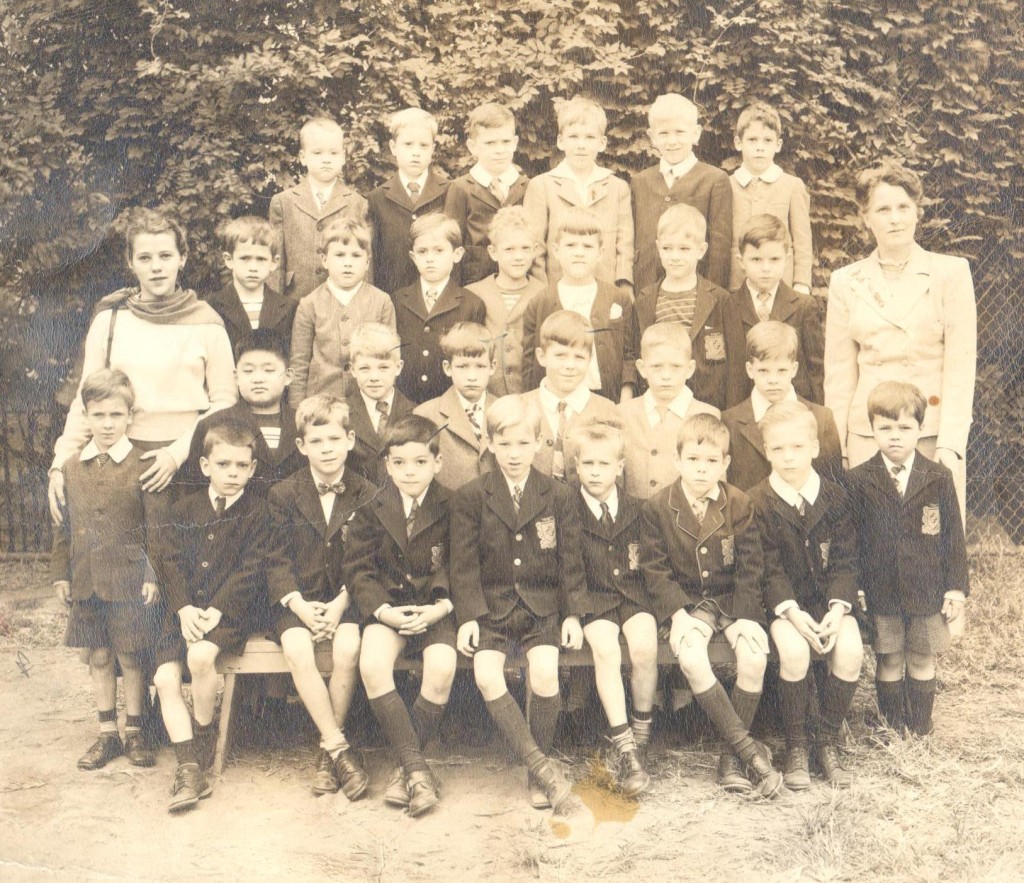Trinity School Class of 1961 Starting with 1st grade 1949-50

… Beginning with the 1st grade
seated: J. Elms, Gleason?, P. Hawkins, _____, A Emmerich, B. Babcock, R. Tollefsen. standing: S. Avendano, Miss Janet Benson, P. Sze, J. Risley, R. Contner, R.Hempel, Wm Dixon, H. Lingerman, G. DeGraff. 2nd row: __, D. Deever, J. Peddy, ___, Hazard, A. Hill, E. Babbitt, P. Clough, Miss Helen Wright. top row: (Stout?), _, Stumpf, J. Moore, W. Eberhart, M. O’Connor, ____?.
Memories are curious things.
Closing exercises were held Friday, May 26, 1950 for this first grade class. Although the school was located on W. 91st St. many of my new schoolmates lived close by me on the East Side and I got to know them first as passengers picked up by the red schoolbus.
Young “Ned” Babbitt and I lived on East 82nd St. just off East End Avenue. From the front room windows of my parents 2nd floor apartment, I could look directly across the street into the ground floor window of Ned’s bedroom
Next to his window was the front door to the building. It was of solid wood. Mr. Newman, the landlord, kept the door painted bright red. Newman was a well dressed elderly man with a monocle and a goatee and we saw him often as he enjoyed standing in front of this building and the several others he owned in the neighborhood, tipping his grey fedora to anyone who might pass by.
Farther west on 82nd St., Walter Eberhart lived in an interesting town house near 2nd Avenue. The ground floor of the building was a garage door behind which his father’s automobile was stored. His father was an architect and had extensively renovated the building so that it extended out into the back yard. I found the idea that dwellings, especially New York Brownstones, were not immutably ordained, very interesting. At the time the great post World War II building boom in Manhattan had barely begun. And the neighborhood as I came to know it growing up seemed to me to be always as it was and would always be.
Up on 85th St., also just off East End Avenue, Raymond Contner and his parents lived on the ground floor in a ‘garden’ apartment. When meeting after school though, we would go instead across the Avenue and into the recently completed Carl Shurz Park and playground. The Park was a depression era project and had been created to cover the lanes of the recently constructed East River Drive (now named The FDR Drive.)
I was eventually to lose contact with Raymond, but a few years later I was to run into his father under different circumstances. In the early 1960’s I worked as an apprentice film editor/ gofer at Robert Lawrence Productions, a company that produced documentary films and commercials for television. It was an exciting time with the industry scrambling to convert from B & W to color technology. “Bergie” Contner, was Raymond’s father, and a union cameraman. He had a colorful reputation on the set that I had been unaware of when Raymond and I would play in the park after school only a few years earlier.
When the Schoolbus stopped to pick up Michael O’Connor, He was waiting in front of the 55th Street entrance to the Wellington Hotel. His father was manager there and I thought that it must be exciting to live in a hotel. Michael and I later were called on to perform duets for various school functions as we were both students of the flute.
Among the other first graders was Arthur Hill, who lived with his parents in a building on West 67th St. We later found out that Arty’s father and my father both graduated just twenty years earlier in the same Columbia College class of 1929. Arty and I would have had no reason to discover this parental connection at the time. We didn’t discover this less than ‘six degrees of separation’ until years later.